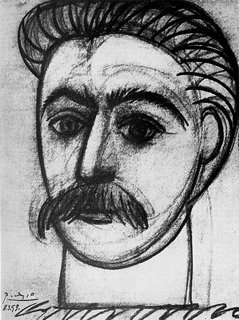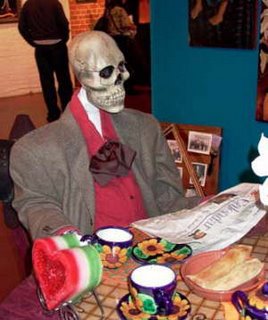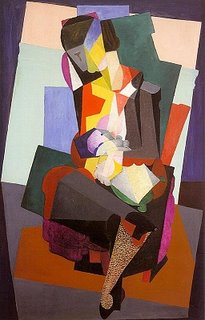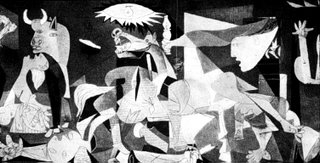
The debate goes on in socialist circles of abstract or surrealism vs. socialist realim.
A new article at a web-site called
"ALLIANCE!" MARXIST-LENINIST Issue 52 April 2003
It attats Cubbism that Picasso started, even though he was a communist and his paintings often reflected his politics. In the artcicle:
"The Problem of Pablo Picasso"
He states:
The cubists rejected an "apparent" reality to be conveyed by normal rules of perspective and modelling. They aimed to show all sides of reality, by displaying a moving history of how objects look over time, and from simultaneously observed but differing, vantage points. It was a "cerebral" exercise therefore, and it rejected any simple notion of how "an object looked":
"Cubism made a radical departure from the idea of art as the imitation of nature that had dominated European painting and sculpture since the Renaissance. Picasso and Braque abandoned traditional notions of perspective, foreshortening, and modelling, and aimed to represent solidity and volume in a two-dimensional plane without converting the two-dimensional canvas illusionistically into a three-dimensional picture-space. In so far as they represented real objects, their aim was to depict them as they are known and not as they partially appear at a particular moment and place. For this purpose many different aspects of the object might be depicted simultaneously; the forms of the object were analysed into geometrical planes and these were recomposed from various simultaneous points of view into a combination of forms. To this extent Cubism was and claimed to be realistic, but it was a conceptual realism rather than an optical and Impressionistic realism. Cubism is the outcome of intellectualized rather than spontaneous vision. " I. Chilvers, H. Osborne, D. Farr. "Oxford Dictionary of Art"; Oxford; 1977; p. 144.
As a movement, following its’ birth with "Les Demoiselles d’Avignon", it rapidly evolved into other movements – but it was one of the key sources of abstractionism in art.”
So right away we see that this Marxist Leninist couldn’t stand abstract art. But what is so bad about it. He goes on to attack Dadaism:
Dadaism involved a "nihilism" [""total rejection of current religious beliefs or morals.. A form of scepticism, involving the denial of all existence," "Shorter Oxford English Dictionary" Volume 2; Oxford 1973; ; p.1404.]. The nihilism of these movements "not only questions the value of art but of the whole human situation. For, as it is stated in another of its manifestos, "measured by the standard of eternity, all human action is futile":
"The historical importance of dadaism and surrealism (lies)…. in the fact that they draw attention to the blind alley …. at the end of the symbolist movement, to the sterility of a literary convention which no longer had any connection with real life .... Mallarme and the symbolists thought that every idea that occurred to them was the expression of their innermost nature; it was a mystical belief in the "magic of the word" which made them poets. The dadaists and the surrealists now doubt whether anything objective, external, formal, rationally organized is capable of expressing man at all, but they also doubt the value of such expression. It is really "inadmissible" - they think, that a man should leave a trace behind him. (Andre Breton: Les Pas perdus, 1924). Dadaism, therefore, replaces the nihilism of aesthetic culture by a new nihilism, which not only questions the value of art but of the whole human situation. For, as it is stated in one of its manifestos,
"measured by the standard of eternity, all human action is futile." (Tristn Tzara: Sept manifestes dada, 1920)."
Yet some Marxist have pointed out that Dadaism started out as anti-war and many were communists. So how could this movement have been so dangerouse. One example given by other Marxist is that it was coopted by the capitalist art societies and later revised to promote fascism in Italy. But is any of this the fault of the artist? Are They responsible for those who misuse their art and try to give it contradictory meenings?
In the Conclusion of the article:
We argue that Picasso ultimately was on the side of the working classes. A "champagne socialist" he may have been – but he did not need to do what he did. As to the worth of his art - where he retained realist images and forms, he showed a power that people understood. But he was constantly reverting to decadent forms and images that placed at an immediate distance between the people and his art. At his best, he moved people. And in that troubling work – "Guernica" – he undoubtedly, has moved and affected generations who have seen it. Again – it is patently, not a piece of "socialist art" – but despite its obvious anti-realist forms, it conveys a very real, and realistic message:
"Down With War!"
Then comes the real killer, the support of socialist realism in the USSR, during the Stalin years.
Impact of Picasso and Guernica on Russian Discussions Upon Socialist Realist Art
A mythology prevails, that there was no discussion - nor knowledge of Western art movements in the socialist years of the USSR (up to 1953). But this is patently false, as there is absolutely no doubt that the Russian artistic scene, was affected by currents in the West. Indeed, the height of knowledge and sensible debates about these various movements is the lie to the general bourgeois line that "there was no debate" and "purely dictatorship" in the USSR. Artistic events in the West were treated very seriously and openly. Undoubtedly post-Second World War there was a renewed debate about the principles of ‘Socialist Realism’:
“At the ninth plenum of the orgkomitet (Organising Committee of the Union of Soviet Artists) held May 1945, some of speakers from the floor brought up the question of innovation in painting, suggesting a new openness to questions of form.... Even court painters and official spokesmen of socialist realism appeared with new faces. The critic V Gaposhkin made a visit to Alexandr Gerasimov's studio and praised highly his unfinished painting of “A Russian Communal Bath' - a major composition of female nudes with no ideological pretext (plate 230). ......... That the mood among some artists and critics, was distinctly rebellious may be may be gleaned from a lecture, entitled ‘The Problem of the 'Impressionism & the problem of the Kartina', delivered by Nikolai Punin to the Leningrad artists' union on 13 April 1946 - and from the reaction to it. Punin's address was an attempt to install impressionism as the basis for the work of Soviet painters; it amounted not only to a revision of the attitude to impressionism which had been imposed in the art press after the debates of 1939-40, but also to a rejection of some of the entrenched principles of socialist realism. He stressed the variety apparent in the painting of the impressionists extolled them as 'honest' and 'contemporary'. He criticised the characterisation of impressionism as some kind of a system..”. Cullerne Bown, Matthew. “Socialist Realist Painting”; New Haven;1998; p.223.
Picasso and his evident partisanship, as expressed in ‘Guernica’ became a part of the debate in the USSR:
“At the discussion on 26 April the artist Petr Mazepov pointed out that impressionism led to the formalist art of cubism and fauvism, in which 'there is no social struggle, the class soul, the party soul, the great soul of the people is absent'.' At this point Mazepov was interrupted from the floor: 'And Picasso?' 'And Cezanne?" And " Guernica, he's a Communist, a party member." A little later Mazepov was interrupted again: 'An artist doesn't have to take up a proletarian position to express his idea'. ................. “
And yet many other Marxist Leninists had been able to promote socialism with out the rigid, humorless stoic Socialist Realism. How about Diego Rivera? He often painted murals, but not all were socialist realism and some where abstract. His wife, Frida Kahlo, also did some unconventional art styles although she repudiated much of her more abstract work right before she died. There was also the Russian Constructivist movement, which was somewhat abstract and fallowed some of the Dadaist formulas. Even the Chinese artist in the Cultural Revolution did not always stick to the rigidness of Socialist Realism. It all had a political slant towards the common man and cadre, yet the form was relaxed enough that some was nearly abstract.
 The Art of Diego Rivera
The Art of Diego Rivera
Below is Soviet and Maoist art that is not Socialist Realism. Soviet Constructivist painted mostly from 1900 to the 1920s. The Chinese art is from the Cultural Revolution.


No comments:
Post a Comment